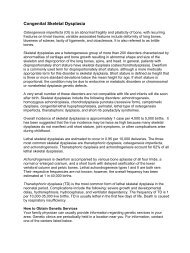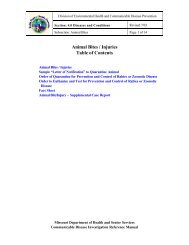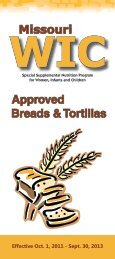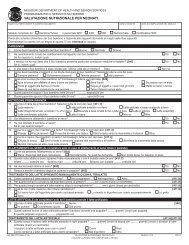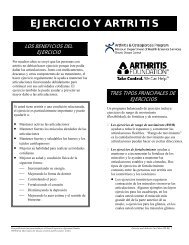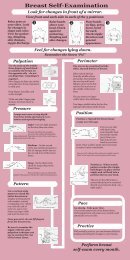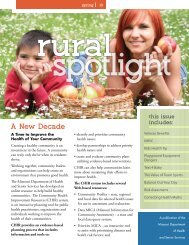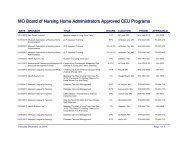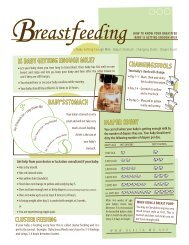Prevention and Control of Communicable Diseases - Missouri ...
Prevention and Control of Communicable Diseases - Missouri ...
Prevention and Control of Communicable Diseases - Missouri ...
Create successful ePaper yourself
Turn your PDF publications into a flip-book with our unique Google optimized e-Paper software.
July 2011<br />
CLEANING, SANITIZING, AND DISINFECTION<br />
This section provides general information about cleaning, sanitizing, <strong>and</strong> disinfecting; guidelines for<br />
specific items commonly used in the childcare <strong>and</strong> school setting; <strong>and</strong> a checklist for choosing a<br />
disinfectant other than bleach.<br />
Definitions<br />
Cleaning Mechanical process (scrubbing) using soap or detergent <strong>and</strong> water to remove dirt,<br />
debris, <strong>and</strong> many germs. It also removes imperceptible contaminants that interfere<br />
with sanitizing <strong>and</strong> disinfection.<br />
Sanitizing Chemical process <strong>of</strong> reducing the number <strong>of</strong> disease-causing germs on cleaned<br />
surfaces to a safe level. This term is usually used in reference to food contact<br />
surfaces or mouthed toys or objects.<br />
Disinfecting Chemical process that uses specific products to destroy harmful germs (except<br />
bacterial spores) on environmental surfaces.<br />
General information<br />
� Lessen the harmful effects <strong>of</strong> germs (bacteria <strong>and</strong> viruses) by keeping their numbers low.<br />
� <strong>Control</strong> germs effectively by frequent, thorough h<strong>and</strong>washing; cleaning <strong>and</strong> sanitizing surfaces <strong>and</strong><br />
objects that come into contact with children; <strong>and</strong> proper h<strong>and</strong>ling <strong>and</strong> disposal <strong>of</strong> contaminated items.<br />
� Follow proper cleaning <strong>and</strong> sanitizing practices whether dirt is seen or not. Germs can live on wet<br />
<strong>and</strong> dry surfaces <strong>and</strong> on those items that do not look soiled or dirty.<br />
� Increase the frequency <strong>of</strong> cleaning <strong>and</strong> sanitizing to control certain communicable diseases.<br />
� Treat all body fluids as infectious because disease-causing germs can be present even in the absence<br />
<strong>of</strong> illness.<br />
� Know that children who do not show symptoms <strong>of</strong> illness may be as infectious as those children who<br />
do have symptoms.<br />
Glove use<br />
� Wear disposable gloves (consider using non-latex gloves as a first choice) when:<br />
- H<strong>and</strong>ling blood (e.g., nosebleeds, cuts) or items, surfaces, or clothing soiled by blood or body<br />
fluids.<br />
- Covering open cuts, sores, or cracked skin.<br />
- Cleaning bathrooms, diapering areas, or any areas contaminated with stool, vomit, or urine.<br />
� Remove gloves properly <strong>and</strong> discard after each use.<br />
� ALWAYS WASH HANDS IMMEDIATELY when gloves are removed. Also wash h<strong>and</strong>s when<br />
there has been contact with any body fluids. Follow h<strong>and</strong>washing <strong>and</strong> gloving procedures.<br />
When using cleaning, sanitizing, or disinfecting products ALWAYS:<br />
� Consider the safety <strong>of</strong> children.<br />
� Choose a product appropriate for the task.<br />
� Follow the label instructions for mixing, using, <strong>and</strong> storing solutions.<br />
� Read the warning labels.<br />
� Store these products safely out <strong>of</strong> reach <strong>of</strong> children.<br />
� Clean soiled surfaces <strong>and</strong> items before using sanitizers or disinfectants.<br />
35



